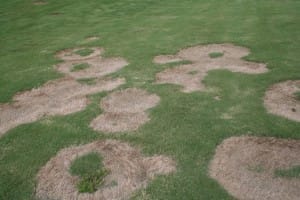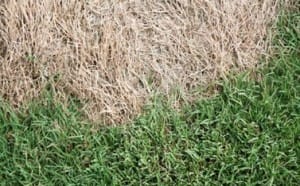Alfredo Martinez, Turfgrass Pathologist, J.B. Workman, Graduate Assistant, Crop and Soil Sciences Department and Clint Waltz, Turfgrass Specialist
This Alert is an excerpt from the publication Identification and Control of Spring Dead Spot

Spring dead spot (SDS) is a persistent and destructive disease of bermudagrass in Georgia. The disease is particularly prevalent and damaging in north Georgia, especially in the Piedmont region. However, SDS can be observed throughout the state after harsh winters and in areas where bermudagrass has been exposed to freezing temperatures for extended periods of time. The disease has also been observed in zoysiagrass, although less frequently.

Symptoms
As turfgrass “greens up,” well-defined circular patches of dead, bleached-out grass are noticeable in affected areas (Figure 1). Non-infected bermudagrass resumes growth, accentuating the infected areas. Sharp edges between dead and healthy grass are observed once turfgrass greens up in spring. (Figure 2).
Roots, rhizomes and stolons are sparse and dark-colored (necrotic) (Figure 3). Leaves become bleached, gray and straw-colored. Recovery from the disease is slow. Because the turfgrass in affected patches is dead, the primary means of recovery occurs by spread of stolons into the patch. Because recovery is dependent on lateral infill of surrounding bermudagrass, symptoms can remain visible well into the
growing season. If not managed properly, these patches may reappear in the same location the following spring along with weed species that may invade the voids. Patches can get larger year after year.
Disease cycle
The fungi casuing the disease are active in the fall and spring when cool, moist conditions exist. They do not kill bermudagrass directly; instead, they make turfgrass more susceptible to cold and freezing injury by feeding on roots, rhizomes and stolons.
Spread of these fungi primarily occurs through movement of infected plants or infested soil by equipment, people, animals and running water.
Infection of the turfgrass begins when soil temperatures are less than 70 °F. Typically, in Georgia, infection of susceptible grasses begins in late September or early October and will continue as long as soil temperatures are above 50° F. Fungal growth and plant infection can resume at these temperatures in early spring, coinciding with bermudagrass transitioning from winter dormancy (also referred to as “green up”).
Disease Control
Complete control of SDS in a single growing season is uncommon. It typically takes two to four years of proper cultural management and fungicide applications before acceptable control can be achieved. This has led to SDS becoming one of the more difficult diseases for growers to manage on an annual basis.
Resistant cultivars
The primary cultivars grown and used in Georgia (e.g., Tifway, TifSport, Tifton 10, Celebration, etc.) have shown susceptibility to SDS. However, SDS tolerance has been enhanced through breeding. Most “tolerant” cultivars (e.g., Patriot) may still get the disease but not as severely. In general, cultivars with more cold tolerance have less SDS than non-cold tolerant bermudagrasses. On sites where SDS has been a chronic problem, conversion to a tolerant cultivar is an option for disease management.
Cultural practices
Cultural practices that improve the cold-hardiness of bermudagrass can be particularly effective for managing SDS.
Since high nitrogen levels can reduce the winter hardiness of bermudagrass, apply no more than ½ pound of nitrogen per 1,000 ft2 be after mid-September.
Potassium applications in the fall (September or October) that total 1 pound of K2O per 1,000 ft2 can be helpful in improving the winter hardiness of bermudagrass and thus reduce SDS severity. Potassium applications should be applied based on soil test results.
A neutral to slightly alkaline soil pH can increase SDS severity. Maintain soil pH at 5.8 to 6.2. Use acid-forming fertilizers on sites with near neutral to alkaline pH. Apply iron, manganese and other micronutrients based on soil test results.
Any soil condition that reduces bermudagrass root growth such as compaction, excessive thatch (> ½ in) and poor drainage can also increase the severity of SDS. Core aeration and other practices that reduce soil compaction and encourage the production of new roots can be helpful in managing this disease.
Chemical Control
Timing, selection and application of fungicides are important for preventative management of SDS. Research has shown that one application of fungicide in the fall when soil temperatures are between 60° and 80° F provides the best control of SDS. When disease pressure is high, growers may want to make two applications. If a second application is necessary, it should be made four to six weeks after the first application when soil temperatures remain between 60° and 80° F. For complete meteorological information, see GeorgiaWeather.net . For improved results, it is recommended that fungicides be applied at high spray volumes (> 5.0 gal / 1,000 ft2) and/or immediately watered-in.
There have been mixed results from turfgrass managers around the state regarding chemical control of SDS. Those who have seen good results say they spray preventative fungicides that target SDS each year and have been doing so for several years. Therefore, it is important to keep in mind that controlling SDS takes time and control usually cannot be obtained in a single season.
A complete list of fungicides, formulations and product updates for SDS can be found in the annual Georgia Pest Management Handbook and the Turfgrass Pest Control Recommendations for Professionals . Some fungicide options are exclusively for golf course settings. Always check fungicide labels for specific instructions, restrictions, special rates, recommendations, follow-up applications and proper handling.
This article is an excerpt from a more complete publication which can be found here.
